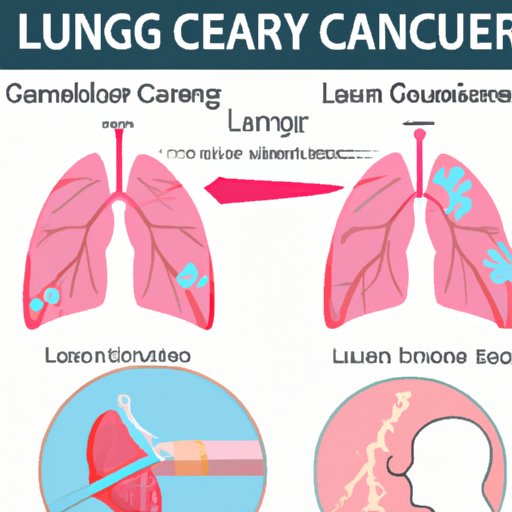
I. Introduction
Lung cancer is one of the most common types of cancer worldwide. It occurs when there is an uncontrolled growth of abnormal cells in one or both lungs leading to difficulty in breathing, chest pain, and persistent coughing, among other symptoms. Unfortunately, lung cancer often spreads quietly without presenting any symptoms, which means that it may go unnoticed until it is too late.
Therefore, it is essential to know the symptoms to watch out for, risk factors associated with lung cancer, diagnosis and testing procedures, different treatment options, living with lung cancer, and most importantly, how it can be prevented.
II. Symptoms to Watch Out For
When it comes to lung cancer, the symptoms presented often depend on the stage of the cancer. Early-stage lung cancer may not present any symptoms while advanced-stage lung cancer can have symptoms ranging from mild to serious.
Common symptoms and warning signs of lung cancer include:
- Persistent coughing for more than three weeks
- Blood-streaked phlegm or mucus from the lungs
- Chest pain or discomfort
- Difficulty breathing or shortness of breath
- Hoarseness or a change in voice
- Unexplained weight loss or loss of appetite
- Feeling tired or weak all the time
- Frequent respiratory infections such as bronchitis or pneumonia
If you have any of these symptoms, please seek medical attention immediately. Early detection and treatment can increase the chances of survival.
III. Risk Factors for Developing Lung Cancer
Various risk factors are associated with lung cancer. However, not everyone who has the risk factors will necessarily develop lung cancer.
The most common risk factor for developing lung cancer is smoking. According to the American Cancer Society (ACS), smoking is responsible for around 80 to 90 percent of all cases of lung cancer.
Other risk factors include:
- Secondhand smoke exposure
- Exposure to radon gas
- Exposure to asbestos or other harmful chemicals
- A family history of lung cancer
- Previous lung diseases such as tuberculosis (TB), chronic obstructive pulmonary disease (COPD), or asthma
It is worth noting that some people are more prone to developing lung cancer than others. For example, men are more likely to develop lung cancer than women, and older people are more likely to develop the disease than younger people.
IV. Diagnosis and Testing
If you are experiencing any of the symptoms mentioned above or have been exposed to any of the risk factors, your doctor may suggest further testing to determine if you have lung cancer.
The tests that may be used to diagnose lung cancer include:
- Chest X-Ray
- Computed Tomography (CT) scan
- Magnetic Resonance Imaging (MRI) scan
- Positron Emission Tomography (PET) scan
- Biopsy: This test is done to extract a tissue sample from your lung or another part of your body where the cancer may have spread.
It is always advisable to speak to your doctor and ask questions if you feel unsure about any of these tests. After receiving a diagnosis, your doctor will suggest the next steps.
V. Coping and Treatment Options
The news of being diagnosed with lung cancer can be devastating, but it is essential to know that there are various treatment options available.
Dependent on the stage of lung cancer, the doctor may suggest surgery, radiation therapy, chemotherapy, immunotherapy or targeted therapy.
Surgery involves the removal of the affected lung tissue. Radiation therapy uses high-energy beams to kill cancer cells. Chemotherapy involves the injection of drugs to shrink or control the growth of cancer cells. Immunotherapy and targeted therapy work by boosting the immune system to attack the cancer cells.
Each treatment has its advantages and disadvantages. Your doctor will be able to advise you on which type of treatment is best for your specific case. Some of the potential side effects of these treatments include fatigue, nausea, hair loss, and increased vulnerability to infections.
It is also essential to come to terms with a diagnosis of lung cancer, hence coping strategies may include engaging with support groups, speaking with family and friends, and considering counseling, among others.
VI. Living with Lung Cancer
Lung cancer not only affects the physical well-being of the person but also the emotional and mental wellness, among others. Specialist teams and healthcare professionals provide expert advice and support to guide people through the different phases of lung cancer treatment and recovery.
Personal stories and experiences from people who have been diagnosed with lung cancer can also provide inspiration to others. These stories can range from highlighting the struggles and challenges faced to the hope and determination for survivors to raise awareness.
VII. Preventing Lung Cancer
Measures to prevent lung cancer include lifestyle adjustments such as quitting smoking, avoiding secondhand smoke, and reducing exposure to environmental pollutants such as radon gas. Individuals should also aim to have a healthy lifestyle through regular exercise, a well-balanced diet and seeking regular medical check-ups.
VIII. Conclusion
Early detection is key to the successful treatment of lung cancer. Understanding the warning signs and risk factors before they become severe can improve health outcomes significantly.
Diagnosis and treatment options are available, which can help with recovery and enhance a patient’s quality of life. Additionally, living in a healthy lifestyle with regular check-ups, healthy eating, and consistent exercise can reduce the chances of developing various diseases.
Finally, for those who have been newly diagnosed with lung cancer, it is essential to find a support system to help you cope, ask questions to gain clarity and lean towards positivity and hope, even while dealing with the difficulties.




